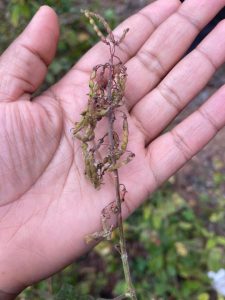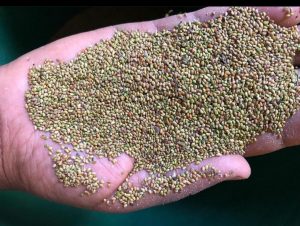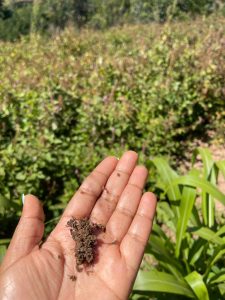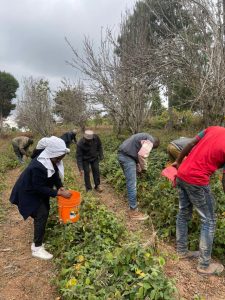Greenleaf Desmodium (Desmodium intortum) is a perennial legume that’s native to Central America but has been introduced to various tropical regions around the world. It is often grown as a forage crop for livestock, but it also plays an important role in soil conservation and improvement. Here’s how:

Photo: Matured Greenleaf Desmodium seeds almost ready for harvest
- Nitrogen Fixation: Like other legumes, Greenleaf Desmodium has the ability to fix atmospheric nitrogen through its symbiotic relationship with Rhizobium bacteria in its root nodules. This means that the plant can convert atmospheric nitrogen into a form that is usable by plants. This helps enrich the soil with nitrogen, reducing the need for synthetic fertilizers.

Photo: Greenleaf Desmodium seeds harvested by Masereka farmers on their Push Pull Farming
- Soil Erosion Control: The dense growth of Greenleaf Desmodium can effectively cover the soil surface, thereby protecting it from direct rain impact and reducing water runoff. This minimizes soil erosion, especially on slopes or in areas prone to degradation.
- Improving Soil Structure: The root system of Desmodium helps in binding the soil particles together. This improves the soil structure, making it less susceptible to compaction and erosion. Over time, this can lead to the formation of a crumbly, well-aerated soil that’s beneficial for other crops.
- Organic Matter Addition: As the plant sheds its leaves and undergoes natural decay, it contributes organic matter to the soil. This enhances the soil’s water retention capacity, provides nutrients, and fosters a healthy microbial community.

- Pest and Weed Control: Greenleaf Desmodium has been used in “push-pull” agricultural strategies, especially in maize farming. It repels (or “pushes”) certain pests like stem borers from the main crops and attracts (or “pulls”) them towards itself. Moreover, its dense growth can outcompete many weeds, reducing the need for herbicides.
- Enhancing Biodiversity: By being a part of mixed cropping or agroforestry systems, Greenleaf Desmodium can increase biodiversity in agricultural landscapes, which can in turn benefit soil health and resilience.

- Increasing Water Infiltration: The plant’s roots create channels in the soil, increasing its permeability. This can lead to enhanced water infiltration rates, reducing surface runoff and ensuring more water is available for crops.

Photo: Push Pull farmers visited by specialist from ICIPE (International Center For Insect Pathology and Ecology) who are the pioneers of Push Pull technologies
In conclusion, Greenleaf Desmodium is not just important for livestock as a forage crop but also plays a vital role in maintaining and improving soil health. This makes it a valuable plant in sustainable and regenerative agricultural systems.

